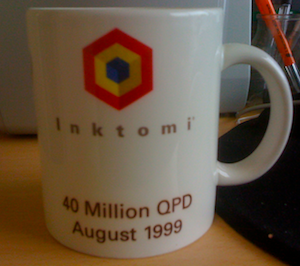 Inktomi back in the day was one of the biggest powers on the Internet, it was even the top search engine for some time. It powered MSN search and was eventually acquired by Yahoo for $240 million.
Inktomi back in the day was one of the biggest powers on the Internet, it was even the top search engine for some time. It powered MSN search and was eventually acquired by Yahoo for $240 million.
But the story you don’t hear very often is how Inktomi died. Diego Basch, a current LinkedIn employee and former Inktomi engineer shared his version in a blog post.
In March 2000 Inktomi had a market cap of $25 billion. Exactly one year later, the stock dropped 99.9 percent. Why?
Basch’s story begins in 1999. Yahoo was Inktomi’s biggest customer and began complaining because when you typed “Yahoo” they weren’t No. 1 in their own search results. Although Inktomi fixed the problem for Yahoo, they couldn’t solve this search problem for many other businesses and websites.
Meanwhile, Google was solving the “relevancy” problem. Google’s PageRank was outsmarting Inktomi, though they didn’t realize it at the time.
Inktomi then tried to build a tool to “measure the relevance effect of algorithmic changes based on precomputed human judgements.” This was a score from 1-10, much like PageRank is today (though hundreds more factors have been added the modern PageRank). This helped solve the majority of ranking problems but didn’t solve the next biggest factor in people using Google, user experience.
“Despite our relevance being so great, there was one huge red flag: engineers at Inktomi were starting to use Google as our search engine.” Basch wrote. The Google experience was far superior to Inktomi’s. Here are the two reasons Basch states:
- Inktomi didn’t control the front-end. We provided results via our API to our customers. This caused latency. In contrast, Google controlled the rendering speed of their results.
- Inktomi didn’t have snippets or caching. Our execs claimed that we didn’t need caching because our crawling cycle was much shorter than Google’s. Instead of snippets, we had algorithmically-generated abstracts. Those abstracts were useless when you were looking for something like new ipad screen resolution. An abstract wouldn’t let you see that it’s 2048×1536, you’d have to click a result.
Google realized that it’s not all about displaying hundreds of results to the user but more about “satisfying the need for information.” As it turns out, Inktomi engineers preferred using Google more than the product that they were building.
Engineers even went so far as to build a slick looking UI for their internal search but the execs of Inktomi determined that they didn’t want to move forward with improving the user experience in this way. This, among with other reasons, is the reason why Inktomi failed.
Google much like Inktomi, must re-evalutate what it’s currently doing. They’re making billions every quarter thanks to advertising, and search is going strong but the Penguin update has raised a lot of questionable results to the surface. Google must be careful to not start declining from here on out.
Right now Google is putting everything into Google+. Over the coming months as Google integrates everything into Google+, Google must remember to keep its users happy, or else they may start looking for more relevant results elsewhere.
 Inktomi back in the day was one of the biggest powers on the Internet, it was even the top search engine for some time. It powered MSN search and was eventually
Inktomi back in the day was one of the biggest powers on the Internet, it was even the top search engine for some time. It powered MSN search and was eventually